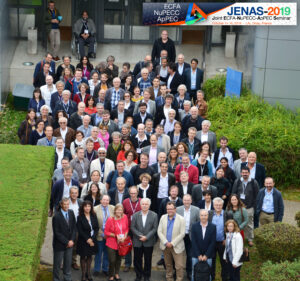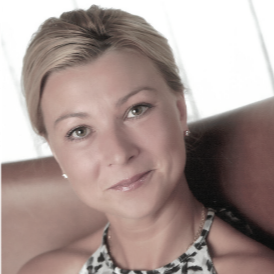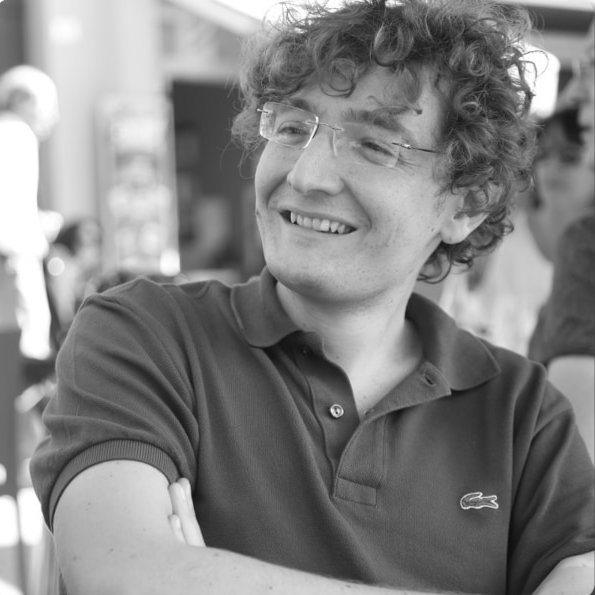
Gravitational Wave Probes of Fundamental Physics – a cross-cutting initiative
Interview on Gravitational Waves Expression of Interest with Tetyana Galatyuk and Paolo Pani
In response to the JENAS call the Gravitational Wave Community prepared an open Expression of Interest on “Gravitational Wave Probes of Fundamental Physics”. Already two weeks after the announcement, the list of endorses counted over 500 people. Tetyana Galatyuk and Paolo Pani, who played a key role in the writing and submission, will explain in this interview the aims and ideas of the EoI.
Can you briefly describe how the idea of this EoI came about?
Tetyana: The landmark detection of gravitational waves has opened a new era in physics, giving access to hitherto unexplored systems. In parallel to their countless astrophysical applications, these discoveries open new avenues to explore fundamental physics in many different aspects at both theoretical and experimental level. In this context, the two of us have been independently involved in efforts to diversify our own communities and strengthen the synergies between different subfields, for example by serving as coordinators of sub-working groups of the COST Action GWverse and as speaker of the Topic Cosmic Matter in the Laboratory (CML) within Helmholtz Program „Materie und Universum“. Recently, we have been approached by Prof. Gianfranco Bertone, who proposed to prepare a JENAS Eol as a way to extend and formalize the synergies among different communities.
Paolo: The idea and the themes of the Eol emerged very naturally, since for some time there has been an underlying feeling that different communities working at the interface between astroparticle, nuclear, and gravitational physics would have enormously benefit from a stronger interaction between each other. In particular, current and future gravitational-wave detections can provide an answer to long-standing open problems in fundamental physics, such as the behaviour of matter under extreme conditions, the nature and phenomenology of dark matter and dark energy, the existence of new fundamental fields, the nature of black-holes, and the quest for possible extensions of Einstein’s General Relativity. Some of these problems are cross-cutting among different disciplines and require new developments at theoretical and experimental level.
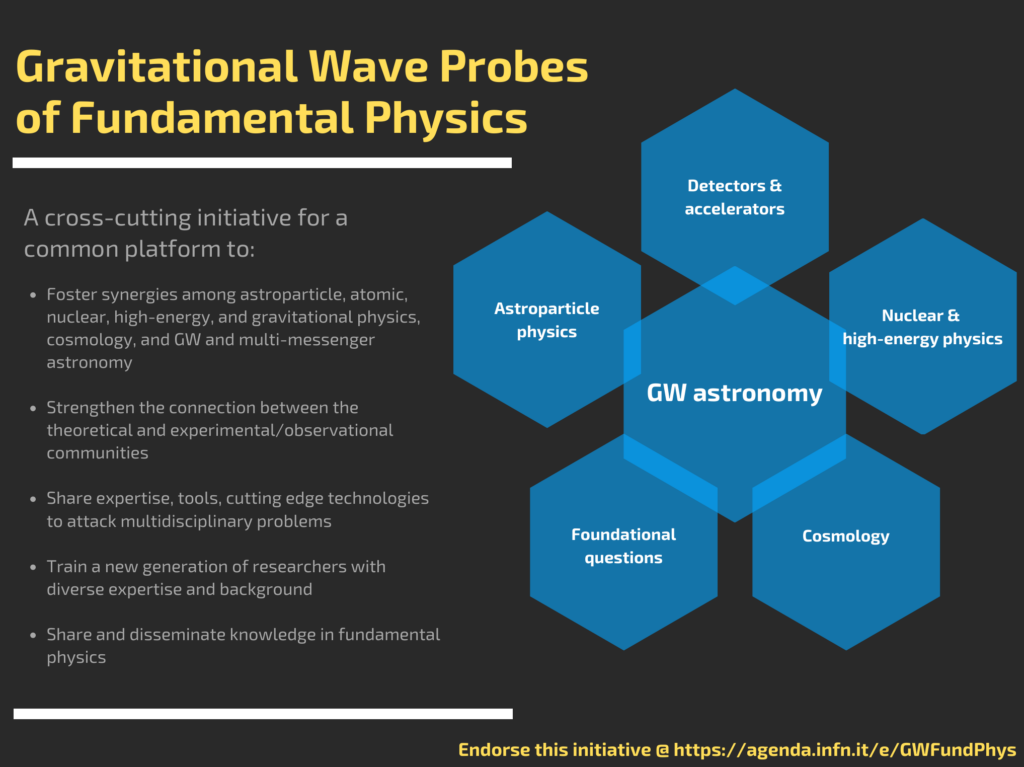
Overview about the EoI of the Gravitational Wave community https:/agenda.infn.it/e/GWFundPhys
What are your main aims?
Tetyana: Given the current state of affairs, our communities are often exploring related problems from different perspectives and could benefit from a common platform to share ideas and expertise. Our goal is to create such a platform, boost current synergies, and explore new ones.
Paolo: We aim to establish a “meta-community” that can embrace different, more specific fields, while at the same time offering a platform for young researchers to be trained and a multidisciplinary visiting program across Europe.
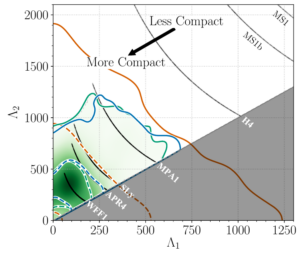
Marginalized posterior for the tidal deformabilities Λ_i of the two binary components of GW170817, the first binary neutron-star event detected by LIGO/Virgo. Smaller Λ_i correspond to more compact stars and, in turn, to a softer equation of state. From Abbott+ Phys. Rev. Lett. 121, 161101 (2018)
How do you envision achieving these aims?
Paolo: First of all, we need to build/consolidate a cross-cutting community. In order to achieve that, we envise organizing a kick-off meeting to get the many scientists who expressed interest in this Eol involved and to discuss with them the best actions. A core part of our proposal will be the training of a new generation of researchers working at the interface between different fields, and this will require another core aspect: the organization of visiting programs that have been proved to be highly beneficial to create synergies among different fields.
Tetyana: A concrete outcome will be the creation and maintenance of a webpage, including a repository to share codes, tools and other data that can be useful in interdisciplinary studies, e.g., state-of-the-art equations of state, observational/experimental data, numerical codes, analytic methods and waveforms models, data-analysis tools, cosmological models.
JENAS was a joint effort from the Particle, Astroparticle and Nuclear Physics Community, how are these three communities represented in your EoI?
Paolo: We precisely aim to foster synergies among different communities, in particular astroparticle, atomic, nuclear, high-energy, and gravitational physics, cosmology, and GW and multi-messenger astronomy.
Tetyana: Given these are the main topics of the APPEC, ECFA and NuPECC, it was just natural to respond to the JENAS call with this Eol.
How could APPEC, ECFA and NuPECC support you?
Paolo: We believe the three consortia can play a key role in our joint initiative. Their support is clearly essential to reach out to all interested colleagues in Europe, and to establish, in a series of kick-off meetings, a forum where particle, astroparticle, and nuclear physicists can meet and identify synergies among different communities, as well as innovative strategies to explore fundamental physics with gravitational waves.
Tetyana: In the medium and long term, we hope that APPEC, ECFA and NuPPEC can help us secure financial support for meetings and for the consolidation of the community, both at EU level and with national agencies.
Are you already planning concrete steps for the near future?
Tetyana: We believe that the most urgent action is to secure funds to kick-start the activities listed in the Eol. We plan in particular to apply for a new COST action.
Paolo: COST actions are particularly interesting as a funding instrument for us, as they have proven to be extremely successful in supporting large scientific networks in Europe, as demonstrated by the related actions GWverse and PHAROS. We will soon reach out to the community to coordinate the submission of the COST Action proposal.
Further information:
- Information and endorsement website: Gravitational Wave Probes of Fundamental Physics
- JENAS call for Expression of Interest
Tetyana Galatyuk is Group Leader “QCD Matter Research” in the department HADES at GSI and Full Professor of Experimental hadron- and nuclear physics at the Institute of Nuclear Physics in Darmstadt. In 2012 she was awarded a Helmholtz Young Investigator Group “Exploring Quark Matter with VIrtual Photons” to study the phase structures of strongly interacting matter under extreme conditions of temperature and density using high-energy heavy-ion collisions and became a Junior Professor at TU Darmstadt. She is the recipient of the 2013 Röntgen-Preis, of the 2009 Preis der Freunde und Förderer der Universität Frankfurt. Her main research topics are the dilepton and hadron spectroscopy with hadron and heavy-ion beams, phenomenology of electromagnetic radiation from heavy-ion collisions, detector instrumentation.
Paolo Pani is Associate Professor of Theoretical Physics at Sapienza, University of Rome (Italy). He is Junior Fellow at Sapienza’s School for Advanced Studies and member of the Scientific Committee of the Amaldi Research Center for gravitational physics. He coordinates the ERC project DarkGRA (“Unveiling the dark universe with gravitational waves”) and other national projects. He received the SIGRAV Prize and the Outstanding Referee award from the American Physics Society. He is co-author of the book “Superradiance” and of over 100 scientific publications on black-hole physics and gravitational-wave phenomenology, and their connections to fundamental physics.




